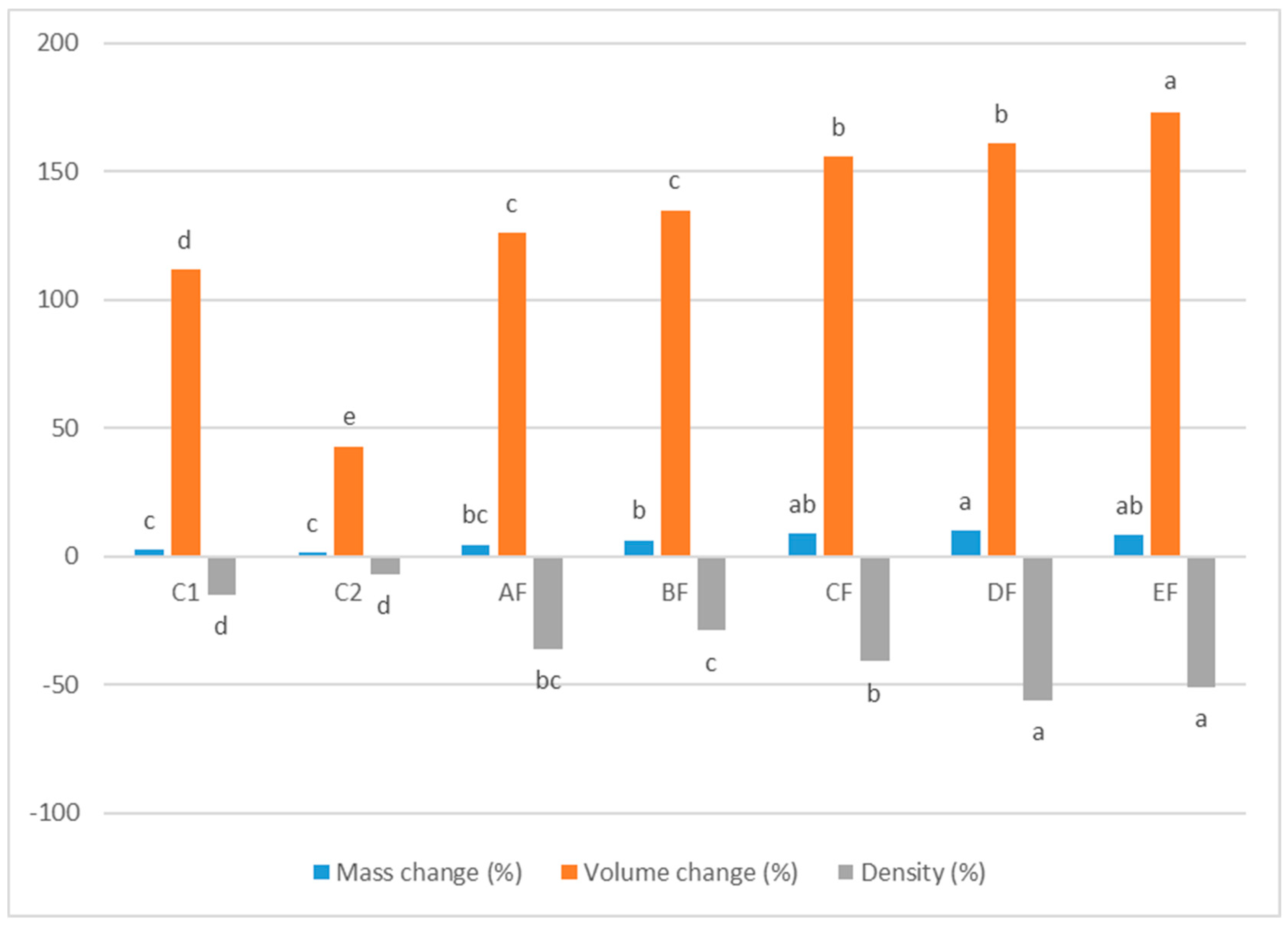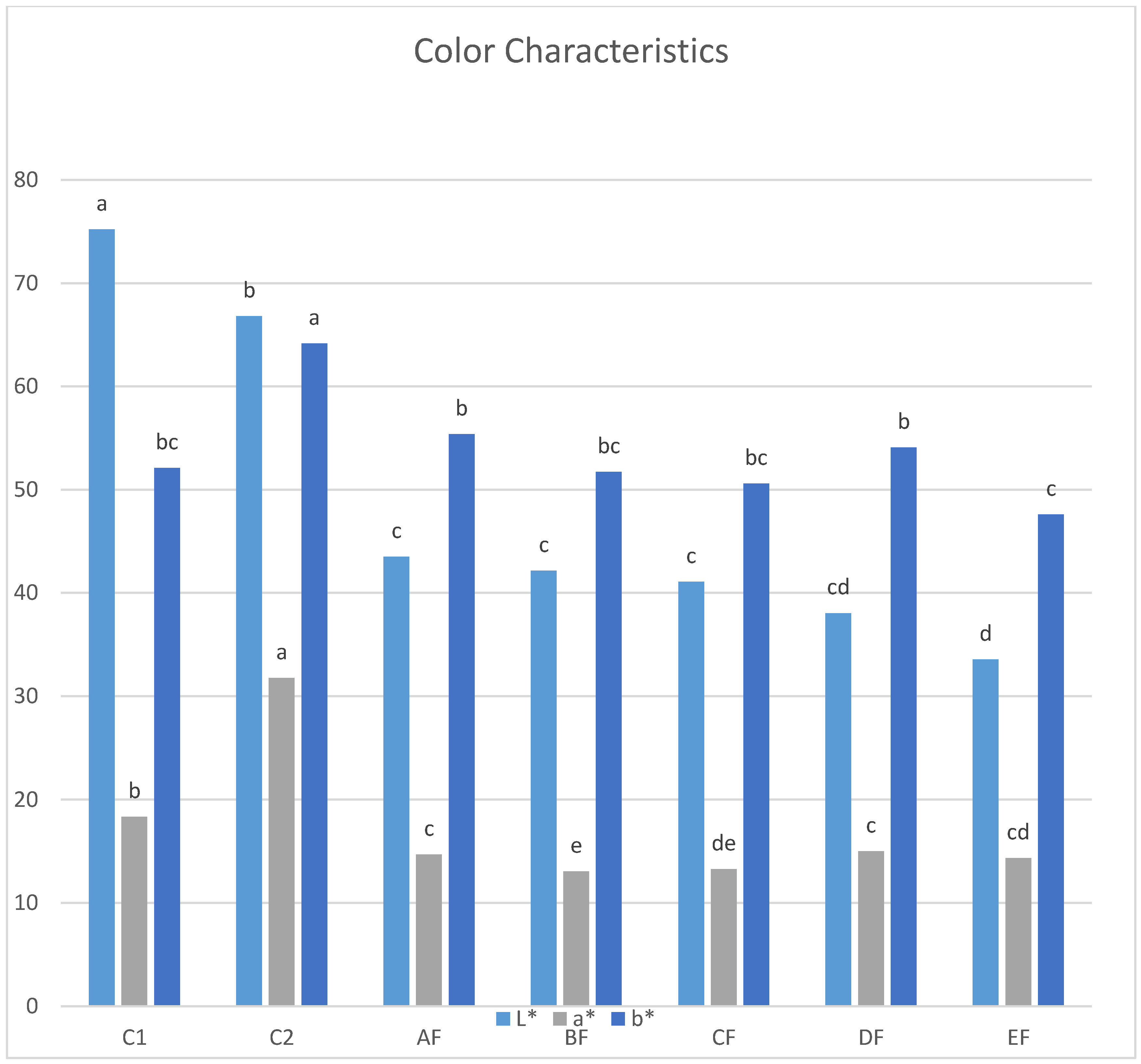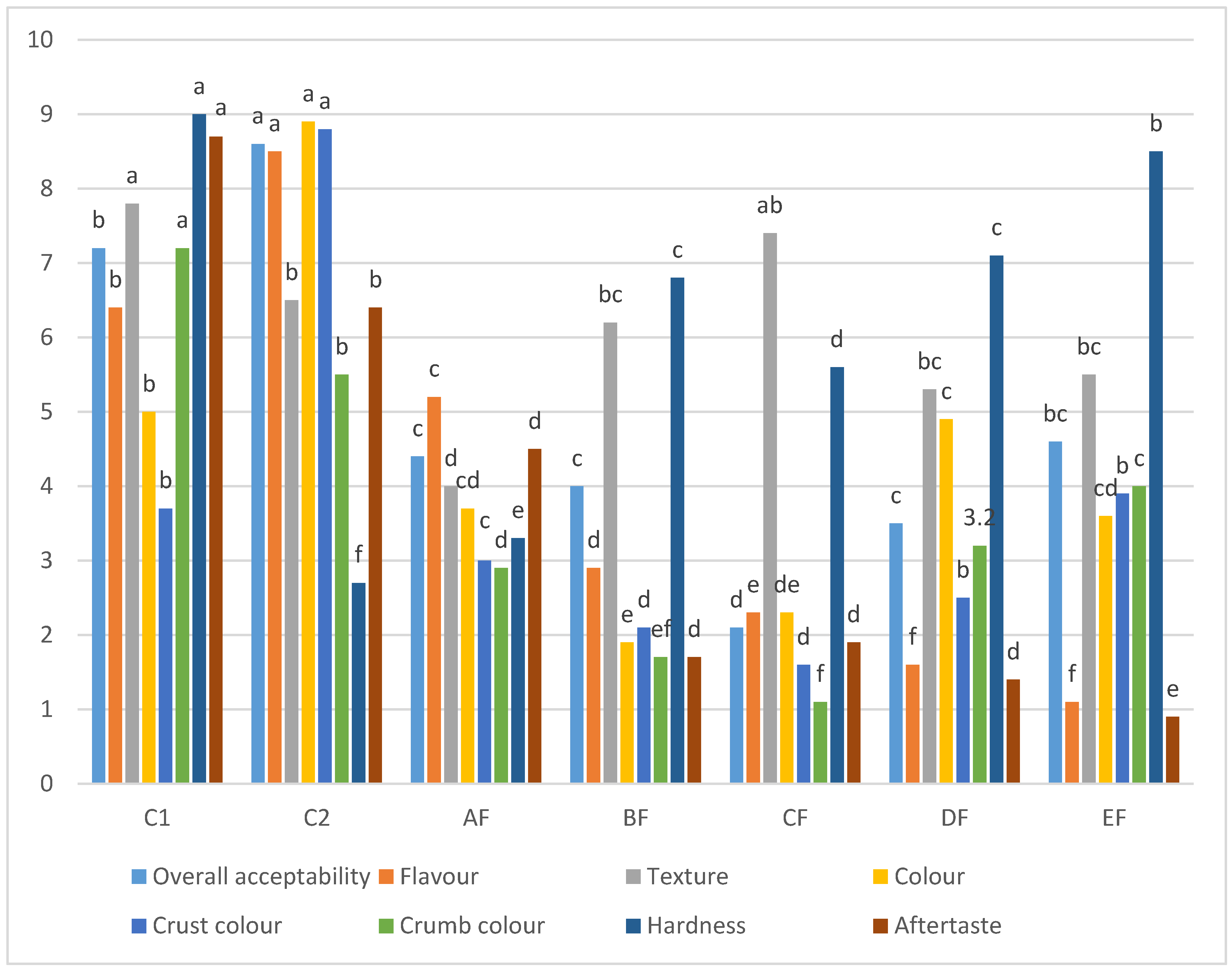Development and Characterization of Nutritious Gluten-Free Doughnuts with Lupin and Inulin Flours
Abstract
1. Introduction
2. Materials and Methods
2.1. Materials
2.2. Preparation of Lupin Seeds
2.3. Doughnut Flour Blends and Preparation
2.4. Chemical Analysis
2.5. Physical Properties of the Gluten-Free Doughnuts
2.5.1. Mass, Volume and Density Measurements
2.5.2. Rheological Characteristics
2.5.3. Colour Measurement
2.6. Sensory Evaluation
2.7. Statistical Analysis
3. Results and Discussion
3.1. Chemical Analysis of the Flours and Doughnuts
3.2. Physical Properties of the Gluten-Free Doughnuts
3.3. Rheological Properties of the Dough
3.4. Sensory Properties of the Gluten-Free Doughnuts
4. Conclusions
Author Contributions
Funding
Data Availability Statement
Acknowledgments
Conflicts of Interest
References
- Sharma, N.; Bhatia, S.; Chunduri, V.; Kaur, S.; Sharma, S.; Kapoor, P.; Kumari, A.; Garg, M. Pathogenesis of Celiac Disease and Other Gluten Related Disorders in Wheat and Strategies for Mitigating Them. Front. Nutr. 2020, 7, 6. [Google Scholar] [CrossRef]
- López, E. Influence of the addition of lupine protein isolate on the protein and technological characteristics of dough and fresh bread with added Brea Gum. Food Sci. Technol. Camp. 2014, 34, 195–203. [Google Scholar] [CrossRef]
- Fasano, A.; Catassi, C. Clinical practice. Celiac disease. N. Engl. J. Med. 2012, 367, 2419–2426. [Google Scholar] [CrossRef] [PubMed]
- Theethira, T.G.; Dennis, M.; Leffler, D.A. Nutritional consequences of celiac disease and the gluten-free diet. Expert Rev. Gastroenterol. Hepatol. 2014, 8, 123. [Google Scholar] [CrossRef] [PubMed]
- Itzlinger, A.; Branchi, F.; Elli, L.; Schumann, M. Gluten-Free Diet in Celiac Disease—Forever and for All? Nutrients 2018, 10, 1796. [Google Scholar] [CrossRef] [PubMed]
- Market Research Future. Gluten Free Bakery Market Information—by ingredients {(Main Ingredients—Rice, Corn, Buckwheat, Quinoa, Others) (Others—Hydrocolloid, Protein source, Flavor), Product Type (Bread, rolls & buns, cakes & cheesecakes, muffins & cup cakes, cookies & biscuit, doughnuts, sandwiches & wraps, dough & butter and others), Distribution Channel (store based & non store based) and Region—Forecast to 2028. 2021. Available online: https://www.marketresearchfuture.com/reports/gluten-free-bakery-market-3228 (accessed on 8 September 2022).
- Prusinsk, J. White Lupin (Lupinus albus L.)—Nutritional and Health Values in Human Nutrition—A Review. Czech J. Food Sci. 2017, 35, 95–105. [Google Scholar]
- Klupšaitė, D.; Juodeikienė, G. Legume: Composition, protein extraction and functional properties. A review. Chem. Technol. 2015, 66, 5–12. [Google Scholar] [CrossRef]
- Erbaş, M.; Certel, M.; Uslu, M.K. Some chemical properties of white lupin seeds (Lupinus albus L.). Food Chem. 2005, 89, 341–345. [Google Scholar] [CrossRef]
- Ruiz-López, M.; Barrientos-Ramírez, L.; García-López, P.; Valdés-Miramontes, E.; Zamora-Natera, J.; Rodríguez-Macias, R.; Salcedo-Pérez, E.; Bañuelos-Pineda, J.; Vargas-Radillo, J. Nutritional and Bioactive Compounds in Mexican Lupin Beans Species: A Mini-Review. Nutrients 2019, 11, 1785. [Google Scholar] [CrossRef] [PubMed]
- Das, S.; Vasudeva, N.; Sharma, S. Cichorium intybus: A concise report on its ethnomedicinal, botanical, and phytopharmacological aspects. Drug Dev. Ther. 2016, 7, 1–12. [Google Scholar]
- Markowiak, P.; Śliżewska, K. Effects of Probiotics, Prebiotics, and Synbiotics on Human Health. Nutrients 2017, 9, 1021. [Google Scholar] [CrossRef]
- AOAC. Official Methods of Analysis of the Association of Official Analytical Chemists, 14th ed.; Horowitz, W., Ed.; Association of Official Analytical Chemists: Washington, DC, USA, 1984. [Google Scholar]
- AACC. Approved Methods of the American Association of Cereal Chemists, 10th ed; methods 08-01, 30-20, 44-15A, 46-12, 54-10, 54-21, 56-81B; American Association of Cereal Chemists: St Paul, MN, USA, 2000. [Google Scholar]
- Meilgaard, M.; Civille, G.V.; Carr, B.T. Sensory Evaluation Techniques, 4th ed; CRC Press: Boca Raton, FL, USA, 2006. [Google Scholar]
- Khouryieh, H.; Aramouni, F. Effect of flaxseed flour incorporation on the physical properties and consumer acceptability of cereal bars. Food Sci. Technol. Int. 2013, 19, 549–556. [Google Scholar] [CrossRef] [PubMed]
- Maghaydah, S.; Abdul-Hussain, S.; Ajo, R.; Tawalbeh, Y.; Elsahoryi, N. Effect of lupine flour on baking characteristics of gluten free cookie. Adv. J. Food Sci. Technol. 2013, 5, 600–605. [Google Scholar] [CrossRef]
- Aniess, W.I.M.; Khalil, A.F.; Mosa, Z.M. Phenolic compounds and antioxidant capacity of sweet lupine derivatives-wheat flour mixtures and the effects on diabetic rats. IOSR J. Environ. Sci. Toxicol. Food Technol. 2015, 9, 61–69. [Google Scholar]
- Onipe, O.O.; Jideani, A.I.; Beswa, D. Composition and functionality of wheat bran and its application in some cereal food products. Int. J. Food Sci. Technol. 2015, 50, 2509–2518. [Google Scholar] [CrossRef]
- Javaria, S.; Marwat, S.; Raza, S.; Hameed, A.; Waseem, K. Formulation of gluten-free baked products for coeliac patients: A review of contemporary methodologies and quality improving factors. Am. Eurasian J. Agric. Environ. Sci. 2016, 16, 826–835. [Google Scholar]
- Hofmanová, T.; Hrušková, M.; Švec, I. Evaluation of wheat/non-traditional flour composites. Czech J. Food Sci. 2014, 32, 288–295. [Google Scholar] [CrossRef]
- Kim, J.; Choi, I.; Shin, W.; Kim, Y. Effect of HPMC (Hydroxypropyl methylcellulose) on oil uptake and texture of gluten-free soy donut. LWT-Food Sci. Technol. 2015, 62, 620–627. [Google Scholar] [CrossRef]
- Lazaridou, A.; Duta, D.; Papageorgiou, M.; Belc, N.; Biliaderis, C.G. Effects of hydrocolloids on dough rheology and bread quality parameters in gluten-free formulations. J. Food Eng. 2007, 79, 1033–1047. [Google Scholar] [CrossRef]
- Salem, E.M.; Hanan, F.A. Partial substitution of eggs by lupin flour and its protein isolates in cakes manufacturing. J. Appl. Sci. Res. 2012, 8, 3717–3723. [Google Scholar]
- Doxastakis, G.; Zafiriadis, I.; Irakli, M.; Marlani, H.; Tananaki, C. Lupin, soya and triticale addition to wheat flour doughs and their effect on rheological properties. Food Chem. 2002, 77, 219–227. [Google Scholar] [CrossRef]
- López-Casado, M.; Lorite, P.; de León, C.; Palomeque, T.; Torres, M. Celiac Disease Autoimmunity. Arch. Immunol. Et Ther. Exp. 2018, 66, 423–430. [Google Scholar] [CrossRef] [PubMed]
- Siriwongwilaichat, P.; Kongpanichtrakul, C. Quality improvement of gluten-free doughnuts by using hydrocolloids. Sci. Eng. Health Stud. 2021, 15, 21030005. [Google Scholar]
- Ahmed, W.; Rashid, S. Functional and therapeutic potential of inulin: A comprehensive review. Food Sci Nutr. 2019, 59, 1–13. [Google Scholar] [CrossRef]
- Paraskevopoulou, A.; Provatidou, E.; Tsotsiou, D.; Kiosseoglou, V. Dough rheology and baking performance of wheat flour–lupin protein isolate blends. Food Res. Int. 2010, 43, 1009–1016. [Google Scholar] [CrossRef]
- Correia, P.; Gonzaga, M.; Batista, L.; Beirão-Costa, L.; Guiné, R. Development and Characterization of Wheat Bread with Lupin Flour. Int. J. Nutr. Food Eng. 2015, 9, 1077–1081. [Google Scholar]
- Singh, J.; Singh, N.; Sharma, T.R.; Saxena, S.K. Physicochemical, rheological and cookie making properties of corn and potato flours. Food Chem. 2003, 83, 387–393. [Google Scholar] [CrossRef]
- Ahmed, A.R. Influence of chemical properties of wheat-lupine flour blends on cake quality. Am. J. Food Sci. Technol. 2014, 2, 67–75. [Google Scholar] [CrossRef]
- Mota, J.; Lima, A.; Ferreira, R.B.; Raymundo, A. Lupin Seed Protein Extract Can Efficiently Enrich the Physical Properties of Cookies Prepared with Alternative Flours. Foods 2020, 9, 1064. [Google Scholar] [CrossRef] [PubMed]
- Levent, H.; Bilgiçli, N. Enrichment of gluten-free cakes with lupin (Lupinus albus L.) or buckwheat (Fagopyrum esculentum M.) flours. Int. J. Food Sci. Nutr. 2011, 62, 725–728. [Google Scholar] [CrossRef] [PubMed]
- Nasar-Abbas, S.M.; Jayasena, V. Effect of lupin flour incorporation on the physical and sensory properties of muffins. Qual. Assur. Saf. Crops Foods 2012, 4, 41–49. [Google Scholar] [CrossRef]



| Constituent (%) | Wheat Flour | Corn Flour | Lupin Flour |
|---|---|---|---|
| Moisture | 13.4 ± 0.85 a | 12.30 ± 0.57 a | 8.13 ± 0.52 b |
| Ash | 0.42 ± 0.10 c | 1.41 ± 0.23 b | 2.88 ± 0.40 a |
| Fat | 1.24 ± 0.18 c | 3.08 ± 0.24 b | 13.10 ± 1.41 a |
| Protein ¥ | 12.41 ± 0.44 b | 7.86 ± 0.13 c | 35.70 ± 2.26 a |
| Crude fibre | 0.13 ± 0.01 c | 0.31 ± 0.01 b | 9.52 ± 1.36 a |
| Carbohydrates | 72.40 ± 1.72 b | 75.04 ± 2.60 a | 30.67 ± 2.37 c |
| Blends § | Moisture (%) ‡ | Ash (%) | Fat (%) | Protein (%) ¥ | Crude Fibre (%) | Carbohydrates (%) | Energy Value (kcal/100 g) |
|---|---|---|---|---|---|---|---|
| C1 | 13.22 ± 0.17 d | 2.09 ± 0.19 c | 8.10 ± 0.30 d | 10.21 ± 0.59 d | 0.16 ± 0.03 f | 66.22 ± 1.60 a | 378.62 |
| C2 | 16.31 ± 0.28 c | 2.23 ± 0.06 c | 4.90 ± 0.08 f | 6.52 ± 0.18 f | 1.13 ± 0.06 e | 68.91 ± 2.35 a | 345.82 |
| AF | 16.25 ± 0.23 c | 3.30 ± 0.11 b | 10.41 ± 0.22 c | 14.70 ± 0.51 c | 3.72 ± 0.10 d | 51.62 ± 1.84 b | 358.97 |
| BF | 17.20 ± 0.10 c | 3.48 ± 0.16 b | 10.85 ± 0.13 c | 15.31 ± 0.46 bc | 4.11 ± 0.04 c | 49.05 ± 1.36 b | 355.09 |
| CF | 18.71 ± 0.44 b | 3.55 ± 0.10 b | 11.79 ± 0.42 b | 15.83 ± 0.61 abc | 4.37 ± 0.08 b | 45.75 ± 2.11 c | 352.43 |
| DF | 19.85 ± 0.23 a | 3.86 ± 0.08 a | 12.04 ± 0.17 ab | 16.34 ± 0.38 ab | 4.70 ± 0.13 a | 43.21 ± 1.06 cd | 346.56 |
| EF | 20.52 ± 0.81 a | 4.15 ± 0.14 a | 12.60 ± 0.26 a | 17.15 ± 0.92 a | 4.81 ± 0.09 a | 40.77 ± 0.71 d | 345.08 |
| Blends § | Water Absorption (%) ‡ | Dough Development Time (min) |
|---|---|---|
| C1 | 54.8 ± 1.41 e | 3.5 ± 0.42 f |
| C2 | 47.3 ± 1.84 f | 6.4 ± 0.56 e |
| AF | 66.1 ± 1.56 e | 7.1 ± 0.28 ed |
| BF | 73.2 ± 3.82 d | 8.6 ± 0.35 d |
| CF | 75.5 ± 1.27 cb | 10.3 ± 0.14 cb |
| DF | 80.2 ± 1.13 ba | 11.4 ± 0.71 b |
| EF | 81.9 ± 2.12 a | 13.6 ± 1.30 a |
Publisher’s Note: MDPI stays neutral with regard to jurisdictional claims in published maps and institutional affiliations. |
© 2022 by the authors. Licensee MDPI, Basel, Switzerland. This article is an open access article distributed under the terms and conditions of the Creative Commons Attribution (CC BY) license (https://creativecommons.org/licenses/by/4.0/).
Share and Cite
AL-Othman, H.; Maghaydah, S.; Abughoush, M.; Olaimat, A.N.; Al-Holy, M.A.; Ajo, R.; Al Khalaileh, N.I.; Choudhury, I.H.; Angor, M. Development and Characterization of Nutritious Gluten-Free Doughnuts with Lupin and Inulin Flours. Foods 2022, 11, 3237. https://doi.org/10.3390/foods11203237
AL-Othman H, Maghaydah S, Abughoush M, Olaimat AN, Al-Holy MA, Ajo R, Al Khalaileh NI, Choudhury IH, Angor M. Development and Characterization of Nutritious Gluten-Free Doughnuts with Lupin and Inulin Flours. Foods. 2022; 11(20):3237. https://doi.org/10.3390/foods11203237
Chicago/Turabian StyleAL-Othman, Hashem, Sofyan Maghaydah, Mahmoud Abughoush, Amin N. Olaimat, Murad A. Al-Holy, Radwan Ajo, Nazieh I. Al Khalaileh, Imranul H. Choudhury, and Malak Angor. 2022. "Development and Characterization of Nutritious Gluten-Free Doughnuts with Lupin and Inulin Flours" Foods 11, no. 20: 3237. https://doi.org/10.3390/foods11203237
APA StyleAL-Othman, H., Maghaydah, S., Abughoush, M., Olaimat, A. N., Al-Holy, M. A., Ajo, R., Al Khalaileh, N. I., Choudhury, I. H., & Angor, M. (2022). Development and Characterization of Nutritious Gluten-Free Doughnuts with Lupin and Inulin Flours. Foods, 11(20), 3237. https://doi.org/10.3390/foods11203237






